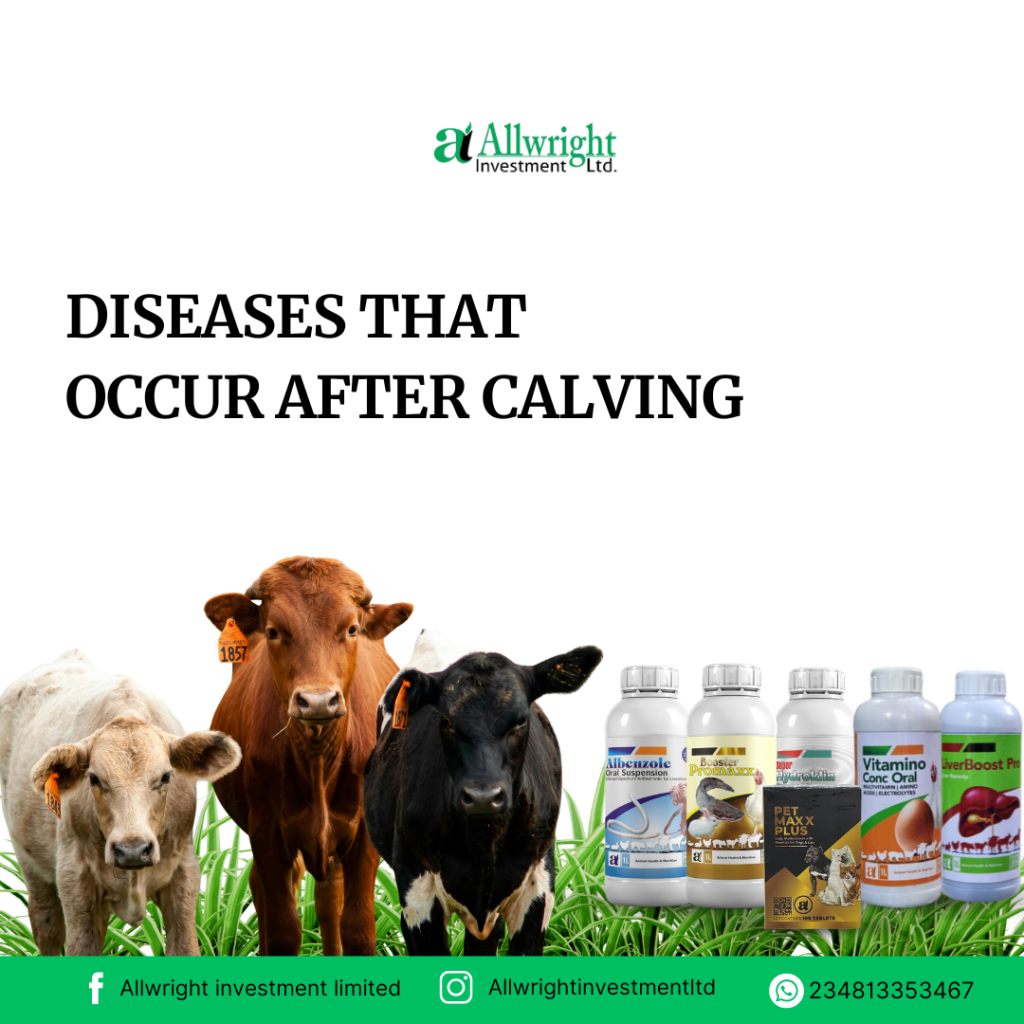
Diseases That Occur After Calving
Calving is a critical period in the lifecycle of dairy and beef cattle. While the arrival of a new calf is a time of celebration, it also marks a vulnerable phase for the mother cow. Post-calving, cows are at a higher risk of developing several health issues due to the physical stress of labor, hormonal changes, and the demands of lactation. As a livestock owner, being aware of these potential diseases and knowing how to prevent or manage them is crucial for maintaining the health and productivity of your herd.
In this blog post, we’ll explore some of the most common diseases that occur after calving, their symptoms, and strategies for prevention and treatment.
1. Milk Fever (Hypocalcemia)
Milk fever is a metabolic disorder caused by low blood calcium levels, typically occurring within 72 hours after calving. It is more common in high-producing dairy cows but can also affect beef cattle.
Symptoms:
- Weakness or inability to stand
- Muscle tremors
- Cold ears and body
- Reduced appetite
- In severe cases, coma or death
Prevention and Treatment:
- Provide a balanced diet during the dry period, focusing on calcium and phosphorus levels.
- Administer calcium supplements or intravenous calcium solutions if symptoms appear.
- Work with a veterinarian to develop a pre-calving nutritional plan.
2. Ketosis (Acetonemia)
Ketosis is a metabolic disorder that occurs when a cow’s energy demands exceed her intake, leading to the breakdown of fat reserves and the production of ketones. It usually occurs in the first few weeks after calving.
Symptoms:
- Reduced milk production
- Weight loss
- Sweet-smelling breath (due to ketones)
- Lethargy and decreased appetite
Prevention and Treatment:
- Ensure cows receive adequate energy intake during the transition period (before and after calving).
- Monitor body condition scores and avoid over-conditioning during the dry period.
- Provide propylene glycol or glucose supplements under veterinary guidance.
3. Retained Placenta
A retained placenta occurs when the fetal membranes are not expelled within 12-24 hours after calving. This condition can lead to infections and other complications.
Symptoms:
- Visible fetal membranes hanging from the vulva
- Foul-smelling discharge
- Fever or signs of infection
Prevention and Treatment:
- Ensure proper nutrition, particularly selenium and vitamin E, during pregnancy.
- Avoid excessive intervention during calving unless necessary.
- Consult a veterinarian for manual removal or treatment with antibiotics if infection is suspected.
4. Metritis
Metritis is a uterine infection that can occur after calving, often associated with a retained placenta or difficult birth.
Symptoms:
- Foul-smelling vaginal discharge
- Fever and lethargy
- Reduced milk production
- Loss of appetite
Prevention and Treatment:
- Maintain clean and hygienic calving environments.
- Monitor cows closely after calving for signs of infection.
- Administer antibiotics as prescribed by us
5. Mastitis
Mastitis, an inflammation of the udder, is a common post-calving issue, especially in dairy cows. It can be caused by bacterial infections or improper milking practices.
Symptoms:
- Swollen, red, or painful udders
- Abnormal milk (clumps, discoloration, or watery consistency)
- Reduced milk yield
- Fever in severe cases
Prevention and Treatment:
- Practice good milking hygiene and ensure proper udder care.
- Regularly check for signs of mastitis and treat early.
- Use antibiotics as recommended by us.
6. Displaced Abomasum (DA)
A displaced abomasum occurs when the cow’s fourth stomach shifts from its normal position, often due to gas buildup. It is more common in high-producing dairy cows after calving.
Symptoms:
- Reduced appetite
- Drop in milk production
- Lethargy and signs of discomfort
- Tinkling sounds from the abdomen
Prevention and Treatment:
- Provide a balanced diet with adequate fiber during the transition period.
- Avoid sudden changes in feed.
- Surgical correction may be necessary in severe cases.
7. Lameness
Lameness can occur after calving due to the physical stress of labor, weight gain, or poor hoof health.
Symptoms:
- Limping or reluctance to move
- Swelling or heat in the hooves
- Reduced activity and feeding
Prevention and Treatment:
- Maintain proper hoof care and trimming schedules.
- Provide clean and dry housing to prevent infections.
- Address nutritional imbalances that may affect hoof health.
Final Thoughts
Post-calving diseases can significantly impact the health, productivity, and profitability of your herd. By understanding the risks and implementing proactive management practices, you can minimize the occurrence of these conditions and ensure a smooth transition for your cows into lactation.
Regular veterinary check-ups, proper nutrition, and a clean, stress-free environment are key to preventing post-calving diseases. Remember, early detection and intervention are critical to successful treatment. If you notice any signs of illness in your cows, consult us immediately.
Taking care of your cows after calving not only benefits their health but also ensures the well-being of their calves and the long-term success of your farming operation. Stay vigilant, stay informed, and keep your herd thriving!
Do you have any experiences or tips for managing post-calving diseases? Share them in the comments below!
Don’t forget to reach out to us to order or become a distributor of our products.

Leave a comment
You must be logged in to post a comment.